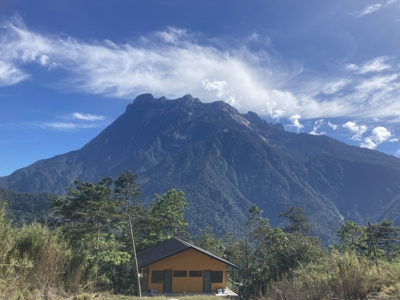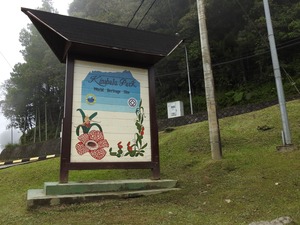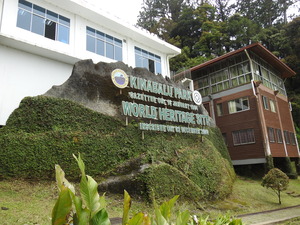Kinabalu Park

Kinabalu Park comprises an array of flora-rich ecosystems across different altitudes and diverse geology.
The park is dominated by Mount Kinabalu, one of the highest mountains in Southeast Asia at 4,095 meters. It is known for its many carnivorous plant and orchid species. It is also home to a multitude of endemic animal species, including the Kinabalu Giant Red Leech and Kinabalu Giant Earthworm.
Community Perspective: the site seems under-reviewed though it is visited regularly. Els describes a disappointing day trip, while birder Frédéric enjoyed himself better across two days. Both visits were restricted to the bottom of the mountain. Nafis was the first one to describe a climb of the mountain.
Map of Kinabalu Park
Community Reviews
Nafis N

I visited Kinabalu Park back in September 2022 with my wife, and we decided to climb Mount Kinabalu as part of our visit. The cheapest climbing option was to book directly via the official site (sabahparks) for the climbing permit and accommodation booking. It's worth pointing out that the climbing permit is limited and always in high demand, especially outside the rainy season (basically avoid Nov - Feb), and the permit booking slots are open in a 6-month window. So, if you're planning to climb the mountain, be on the lookout for the announcement once the booking window is open. The safest bet is to follow Sabah Parks official FB page. They will have a set allocation for independent visitors (booking done through sabahparks.com reservation portal) and visitors via agencies if I'm not mistaken.
As we flew to Kota Kinabalu from Kuala Lumpur and didn't plan to rent a car or take a bus, we opted to book through an agency. The package included return transportation to Kinabalu Park and stops at Jambatan Tamparuli, Desa Dairy Farm, Kundasang market, and Poring Hotsprings. We decided to skip Poring Hotsprings so that we could have more time spent at the park itself.
On the first day, we arrived at Kinabalu Park around 3pm, greeted by clouds concealing the Kinabalu summit. After checking in at Sutera Sanctuary Lodges, the only accommodation within the park, we took a walk along the one-way road, spotting Bornean Stubtail, Mountain Wren-Babbler, and Ochraceous Bulbul. As the clouds cleared momentarily, we witnessed the glorious Kinabalu summit, creating anticipation for our ascent in the following days. As sunset approached, the fog enveloped the park, adding a mystical atmosphere.
The next day, while heading for breakfast, we spotted more endemic birds: Bornean Treepie and Borneo Thrush, along with a Grey Wagtail. We then collected our permit cards from the park HQ, required for check-in at Panalaban later that day. After a van ride to the Timpohon Gate, the hike's starting point, we received a briefing from our guide. I'm going to skip most of the details of the hike itself as the Kinabalu hike had been well documented on the internet by other hikers/vloggers. They are pretty much the same. The hike to Panalaban took us from 9:00 am to 4:30 pm. The climb to Panalaban was made interesting by the gradual change in vegetation around us. We were very lucky that day as the weather was clear and sunny all day, and the sunset at Panalaban was simply breathtaking.
We had to sleep early that night and wake up at 2:00 am the next day. Breakfast first (sausages, bread, and scrambled eggs), then we had to get prepared for the final hike which started at 2:30 am. Equipped with our headlamp, we climbed up the wooden stairs for hours in the dark, under the beautiful stars. We managed to reach the cut-off point called Sayat-Sayat Checkpoint in time at 4:20 am. From there, we continued toward the peak, experiencing a unique section of the climb with fewer trees, horizontal terrain, and stunning rock formations. The hike between Sayat-Sayat Checkpoint and the peak was, without a doubt, my favorite part of the climb. The trees became fewer and fewer, and the climb became more horizontal instead of vertical. In that section, we were just walking from one side of the moutaintop to another part. The surrounding areas were like on a totally different planet with stunning rock formations around us. The final ascent itself felt less remarkable, with a rocky and narrow path crowded with climbers going up and down simultaneously.
Descending, we were rewarded with panoramic views of Kundasang and the surroundings while making our way down (see photo). It was amazing. The only downside was that we couldn't take our time to enjoy the view because we had to check-out from Panalaban by 10.30am. Every additional 30 mins of late check-out will incur a penalty of RM50, which was unfortunate, but I guess they had to implement that to ensure a smooth operation since the accommodation is always limited at Panalaban. Luckily, we reached back at Panalaban around 10:20 am, so we quickly packed our stuff, checked out, then had late breakfast (and a very short break) before continuing our climb back to the park HQ. We arrived at Timpohon Gate around 5:00 pm, enduring heavy rain that transformed the trail into mini waterfalls on the way down. We also spotted a huge Kinabalu Giant Earthworm on the way down which was super cool. We got back to Kota Kinabalu later that night, and we could barely walk to our hotel room after two days of rigorous hiking (9:00 am to 4:30 pm on Day 1, 2:30 am to 5:00 pm on Day 2).
We consider ourselves fortunate to have completed the climb, as poor weather conditions prevented the group that was supposed to climb the day before (whom we crossed paths on our first day as they're climbing down). They were stopped at Sayat-Sayat Checkpoint due to heavy rain.
Our trip to Kinabalu Park was a remarkable experience that solidified its deserving status as a World Heritage Site. The landscapes, flora and fauna, and captivating changes in vegetation along the climb to Mount Kinabalu showcased the best part of the park's natural beauty. The limited availability of climbing permits also helped in contributing to this experience.
Frédéric M

Kinabalu Park is included on the World Heritage List mainly because of the extraordinary plant diversity resulting from its particular topography. In fact, Mount Kinabalu creates a gradient of climatic and edaphic conditions enabling an incredible number of plants to thrive. The isolation of certain populations resulting from this topography has also favoured the emergence of a large number of endemic species. The best way to visit the park, as described in some of the reviews here, is therefore to reach the summit and tackle this climatic and topographical gradient yourself. Unfortunately, although I'm quite the target audience for such an attraction, the staggering cost of the excursion put me off and I won't be describing a trip to the summit to you. Indeed, it's compulsory to reach the summit in two days with a guide, and only one company has a monopoly on accommodation on the mountain. As a result, a night in a basic dormitory can cost upwards of $500, to which must be added park access fees and the guide's fee. Nevertheless, there's plenty to do at the bottom of the mountain.
I visited the park over two days in February and March 2023. It's easy to get to the park from Kota Kinabalu thanks to the minibuses that frequently leave the city on their way to Ranau. However, on the morning of my departure, the only other passengers present at the minibus stop were an American couple on their honeymoon who had been waiting for other passengers to arrive for over an hour. We paid the full fare, shared between the three of us. When I arrived at the park, I asked if there was a two-day rate, as I was planning to come back the next day (I knew full well there wasn't). The lady at the gate was kind enough to write on my ticket that I had paid for two days without charging it to me. I picked up a map at the park information office and explored the Silau-Silau trail and the main road to the summit checkpoint. Along the way, there are several viewpoints (including one with a big WH sign), the aptly named Mountain View trail and good bird-watching opportunities. I was hoping to sneak past the guardhouse and get close to the summit without sleeping there. But that's impossible. It looks like a military checkpoint with a guard and barbed wire. Take note that the Bukit Ular and Liwagu trails were closed (and they didn't seem to be about to reopen), forcing me to return by road. The small botanical garden featured a few Nepenthes, but was rather disappointing (little information on the plants, which were themselves very poorly showcased). I ended my day at the park museum (very interesting) and at the mountain viewpoint directly at the entrance. It was at this point that the clouds cleared the most (photo)!
The next morning, I returned to the park to hike the Kiau View, Mempening and Bundu Tuhan View trails. Although they didn't offer interesting views, despite their names, these trails were quite enjoyable. They offered me the best birding opportunities, including a crimson-headed partridge, a magnificent Whitehead's broadbill, a fiery minivet (see Els' photo), and a few chestnut-crested yuhinas, indigo flycatchers and Bornean forktails. I also took part in a guided hike with a naturalist (offered daily at 11am). Or so I thought. It turned out that I knew the forest better than she did... Since I was the only participant in this guided hike, I simply took a walk in the forest in her pleasant company. I was able to ask her about my plans for the afternoon, which included a trip to Poring hot springs, where I'd read that Rafflesia could be seen. She informed me that there were none in bloom at the moment in Poring, but, thanks to her contacts, she referred me to the Kokob Rafflesia Conservation Garden (outside the park and therefore outside the WHS), where a specimen was indeed in bloom. The park's transport office offered to take me there for an exorbitant fee, but in the end I was able to hitchike to get there.
Finally, although the summit remained out of my reach, I thoroughly enjoyed my visit to Kinabalu Park. The views of the mountain studded with waterfalls are sublime. And the jungle is pristine, criss-crossed by pleasant paths and populated by multicolored birds. A single day might be enough for travellers in a hurry.
Els Slots

Well, 141 community members visited before me and no more than 3 managed to write a short review. The last review was in 2012. None have submitted photos, and the main site photo we had was from the Public Domain. Still, the site has achieved a decent 3.38 rating. So is there something wrong with Kinabalu Park?
Overall, I think it is a worthy WHS, but not a good day trip destination. The higher scores may have come from people who climbed the mountain. I think the benefit of climbing is seeing the change in vegetation, and that’s also Kinabalu’s main OUV.
Like most others, I had to make do with a few hours around the Park Headquarters. The entrance fee for foreigners now is 50 ringgit, which I find a lot – certainly compared to Gunung Mulu where you can enter for 5 days for 30 ringgit. And the visiting conditions at Kinabalu are much worse: I didn’t get a map or any instructions upon entering (they just took the money), trails don’t look maintained, and there’s car traffic, and poor signage. The only part I liked well enough was the small Botanical Garden, which has an additional entrance fee! I wanted close-up views of pitcher plants, and they have several species in a flowerbed accompanied by a large sign stating “Protected Plant. Do not Disturb”.
I suspect that one of the reasons for the lack of photos is that the peak of Mount Kinabalu is often covered in clouds. We were lucky when we passed the main viewpoints around 9.15 a.m., and the van driver even stopped and took pictures with his phone as he said that it isn’t often that clear.
Read more from Els Slots here.
Bernard Joseph Esposo Guerrero
There are two vantage points where a traveler can see the inscribed area --- the National Park Headquarters, and Poring Hot Springs in Ranau(What people say about Poring Hot Spring is true - its too expensive, obviously a tourist trap. A bit elitist for budget travelers like me). I never got to climb it. But, going to those two vantage points proved to be still difficult for DIY travelers. For one, asking directions from locals was confusing. It seems that even those from the area don't know much about the ins and outs of seeing the sites. Many would suggest taking a tour, or by renting a taxi, convincing you that its the best way to go to those places. However, buses are available that would lead to the gates of Kinabalu Park HQ. Nevertheless, I felt that the place is truly gifted and is well deserved of a WHS status.
Elisabeth Fransisca Situmorang
Really deserved the title as one of the WHS. The park is beautiful, and as I happen to manage to climb the Kinabalu Mountain, I could see more of the park area, which is just stunning.
I managed to see a beautiful waterfall from afar... and unfortunately it's quite unreachable there... but I'm glad it's part of the park, so it is also considered as a heritage :-)
John booth
For a spectacular view if the mountain, take the 7am flight from Kota Kinabalu to Sandakan (home of the orang-utans and turtles). That early the air is clear for an uninterupted view.
We enjoyed taking the canopy walkway near the Poring hot springs,to stroll through the treetops.
The brilliant orchid flowers made a colourful display in the forest.
Buses from Kota Kinabalu and Sandakan stop at the park entrance, but the it is such a large area that you really need you own transport to get around.
Community Rating
- : Elisabeth Fransisca Situmorang Randi Thomsen Naim Y Michael anak Kenyalang Nafis N Marton Kemeny Disnsam Ingatastic MC
- : YAO WEI Travelure Kbtwhs
- : Frederik Dawson Gary Arndt Philipp Peterer Chalamphol Therakul CalvinLoh Frédéric M Byronb
- : Solivagant Peter Lööv Svein Elias Zoë Sheng Riccardo Quaranta ReallyDeepThoughts
- : Els Slots Xiquinho Silva Jeanne OGrady Mike Shandos Cleaver Tevity M.HATADA Philipp Leu Richardleesa Allnamesused Akhilpreeti
- : Bernard Joseph Esposo Guerrero Rickard Alfredsson Carlo Sarion
- : Szucs Tamas Wojciech Fedoruk Alex Marcean Adrian Turtschi
- : Julio Moreno
Site Info
Site History
2000 Inscribed
Site Links
Unesco Website
Official Website
In the News
Connections
The site has 38 connections
Constructions
Damaged
Ecology
Geography
Human Activity
Individual People
Religion and Belief
Science and Technology
Timeline
Trivia
Visiting conditions
WHS Names
WHS on Other Lists
World Heritage Process
Visitors
171 Community Members have visited.

